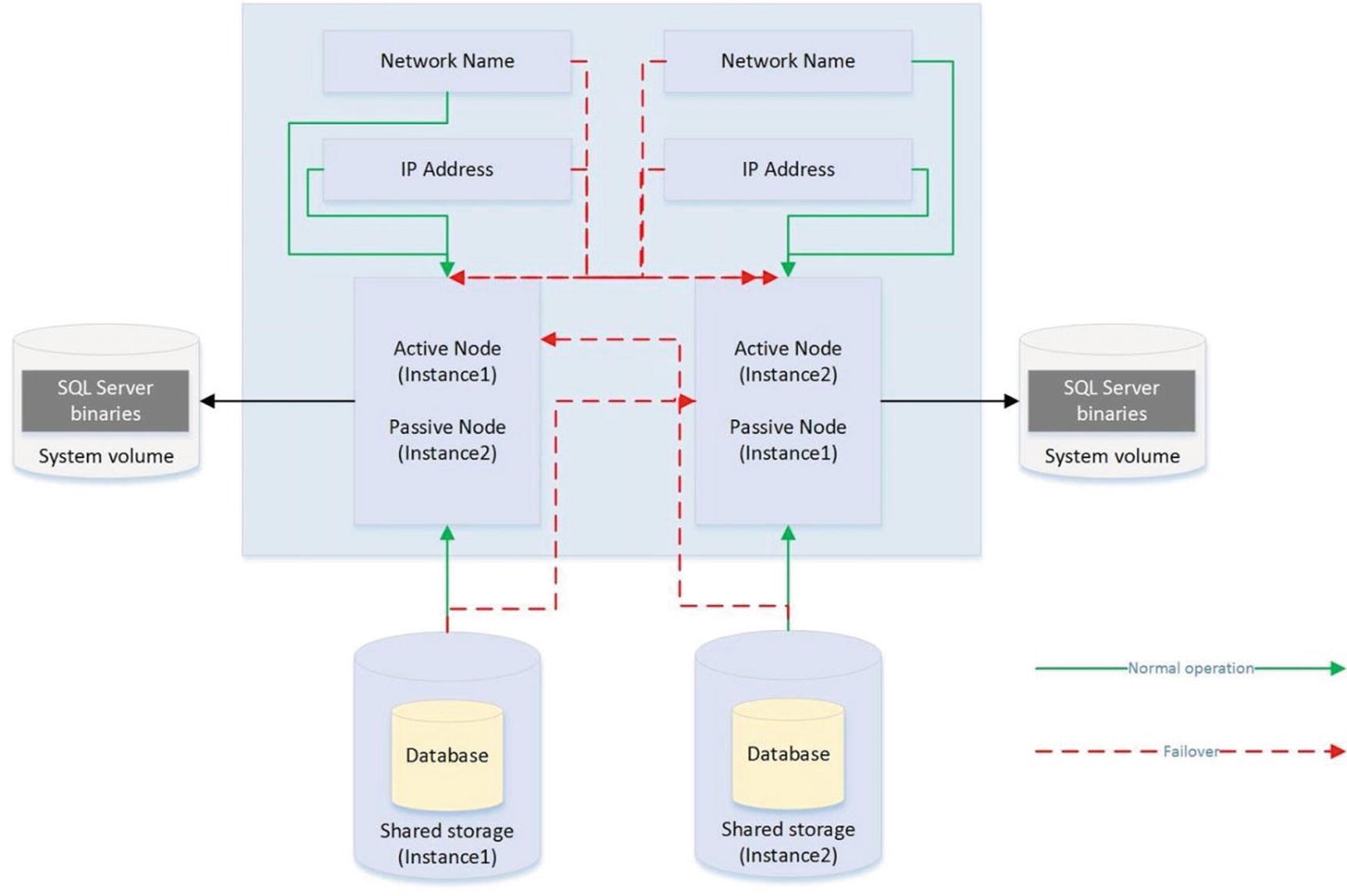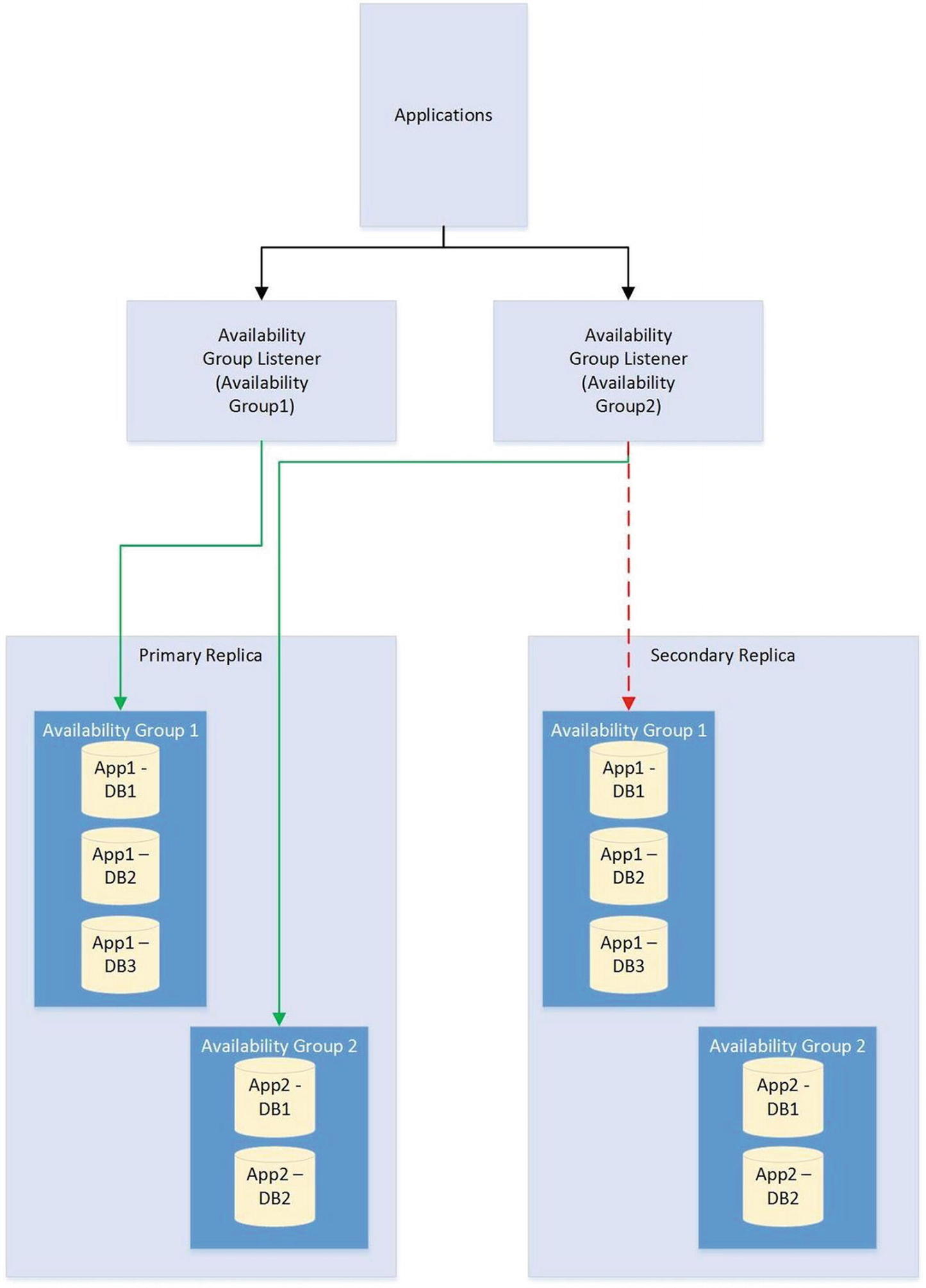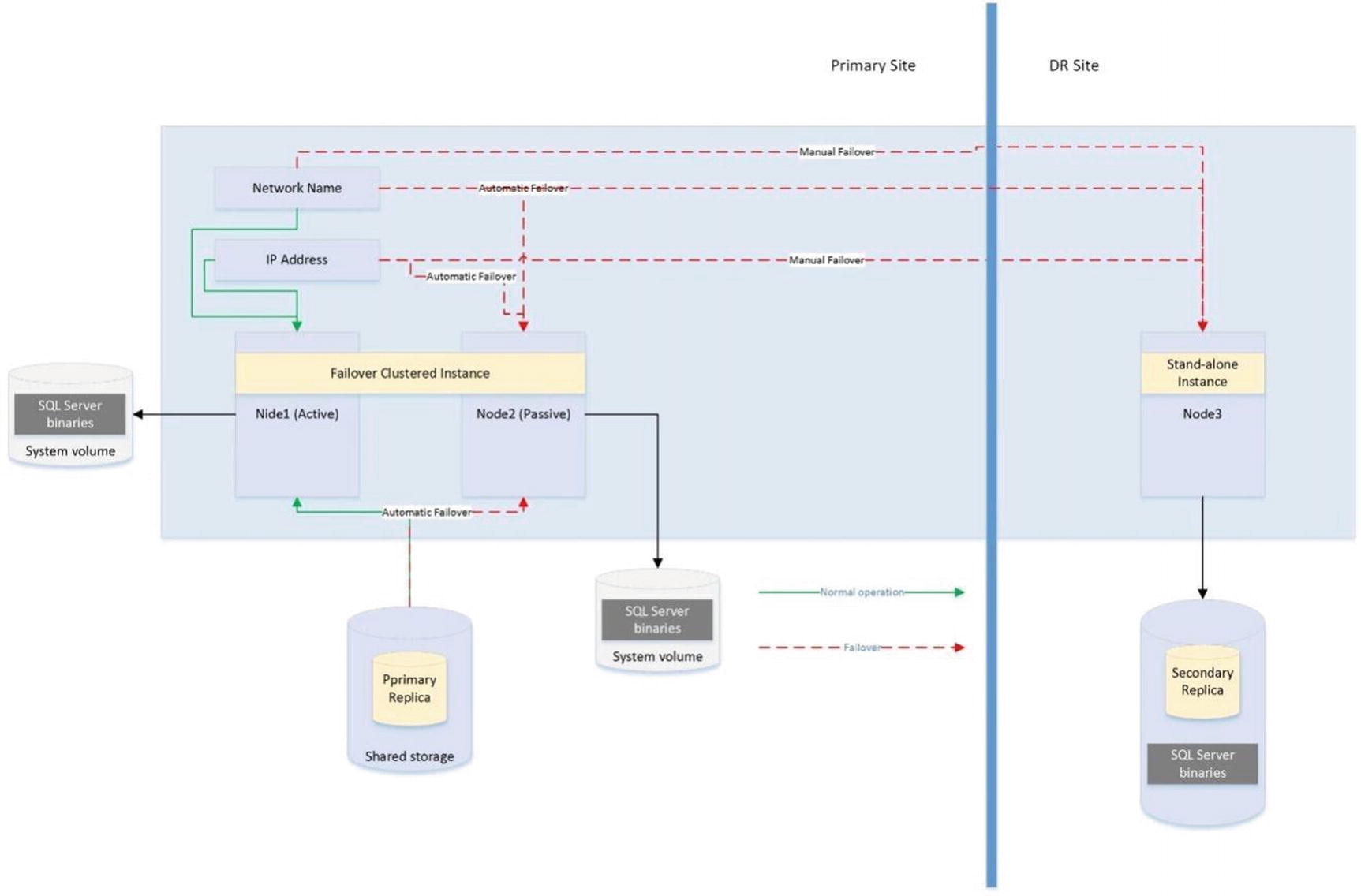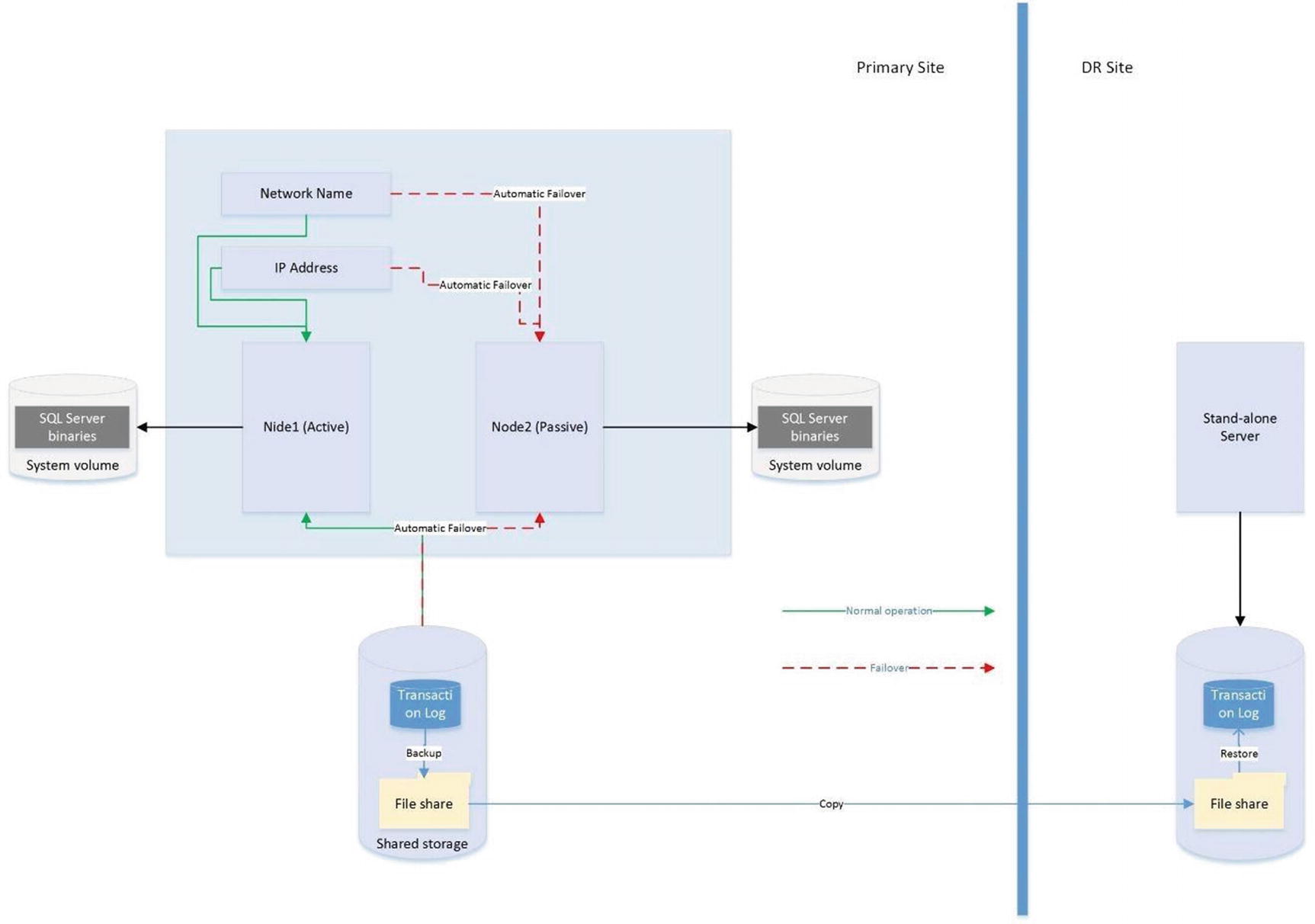SQL Server provides a full suite of technologies for implementing high availability and disaster recovery. The following sections provide an overview of these technologies and discuss their most appropriate uses.
AlwaysOn Failover Clustering
A Windows cluster is a technology for providing high availability in which a group of up to 64 servers works together to provide redundancy. An AlwaysOn Failover Clustered Instance (FCI) is an instance of SQL Server that spans the servers within this group. If one of the servers within this group fails, another server takes ownership of the instance. Its most appropriate usage is for high availability scenarios where the databases are large or have high write profiles. This is because clustering relies on shared storage, meaning the data is only written to disk once. With SQL Server–level HA technologies, write operations occur on the primary database and then again on all secondary databases, before the commit on the primary completes. This can cause performance issues. Even though it is possible to stretch a cluster across multiple sites, this involves SAN replication, which means that a cluster is normally configured within a single site.
Each server within a cluster is called a node . Therefore, if a cluster consists of three servers, it is known as a three-node cluster. Each node within a cluster has the SQL Server binaries installed, but the SQL Server service is only started on one of the nodes, which is known as the active node . Each node within the cluster also shares the same storage for the SQL Server data and log files. The storage, however, is only attached to the active node.
In geographically dispersed clusters (known as geoclusters or stretch clusters), each server is attached to different storage. The volumes are updated by SAN replication or Windows Storage Replica (a Windows Server technology, introduced in Windows Server 2016, which performs storage replication). The cluster regards the two volumes as a single, shared volume, which can only be attached to one node at a time.
If the active node fails, then the SQL Server service is stopped and the storage is detached. The storage is then reattached to one of the other nodes in the cluster, and the SQL Server service is started on this node, which is now the active node. The instance is also assigned its own network name and IP address, which are also bound to the active node. This means that applications can connect seamlessly to the instance, regardless of which node has ownership.

Two-Node Cluster
Active/Active Configuration
Although the diagram in Figure 2-1 illustrates an active/passive configuration , it is also possible to have an active/active configuration. Although it is not possible for more than one node at a time to own a single instance, and therefore it is not possible to implement load balancing, it is, however, possible to install multiple instances on a cluster, and a different node may own each instance. In this scenario, each node has its own unique network name and IP address. Each instance’s shared storage also consists of a unique set of volumes.

Active/Active Cluster
In an active/active cluster, it is important to consider resources in the event of failover. For example, if each node has 128GB of RAM and the instance hosted on each node is using 96GB of RAM and locking pages in memory, then when one node fails over to the other node, this node fails as well, because it does not have enough memory to allocate to both instances. Make sure you plan both memory and processor requirements as if the two nodes are a single server. For this reason, active/active clusters are not generally recommended for SQL Server.
Three-Plus Node Configurations
As previously mentioned, it is possible to have up to 64 nodes in a cluster . When you have three or more nodes, it is unlikely that you will want to have a single active node and two redundant nodes, due to the associated costs. Instead, you can choose to implement an N+1 or N+M configuration.

Three-Node N+1 Configuration
In an N+1 configuration, in a multifailure scenario, multiple nodes may fail over to the passive node. For this reason, you must be very careful when you plan resources to ensure that the passive node is able to support multiple instances. However, you can mitigate this issue by using an N+M configuration.

Five-Node N+M Configuration
Quorum
So that automatic failover can occur, the cluster service needs to know if a node goes down. In order to achieve this, you must form a quorum. The definition of a quorum is “The minimum number of members required in order for business to be carried out.” In terms of high availability, this means that each node within a cluster, and optionally a witness device (which may be a cluster disk, a file share that is external to the cluster or Azure BLOB storage), receives a vote. If more than half of the voting members are unable to communicate with a node, then the cluster service knows that it has gone down and any cluster-aware applications on the server fail over to another node. The reason that more than half of the voting members need to be unable to communicate with the node is to avoid a situation known as a split brain .
To explain a split-brain scenario, imagine that you have three nodes in Data Center 1 and three nodes in Data Center 2. Now imagine that you lose network connectivity between the two data centers, yet all six nodes remain online. The three nodes in Data Center 1 believe that all of the nodes in Data Center 2 are unavailable. Conversely, the nodes in Data Center 2 believe that the nodes in Data Center 1 are unavailable. This leaves both sides (known as partitions) of the cluster thinking that they should take control. This can have unpredictable and undesirable consequences for any application that successfully connects to one or the other partition. The Quorum = (Voting Members / 2) + 1 formula protects against this scenario.
If your cluster loses quorum, then you can force one partition online, by starting the cluster service using the /fq switch. If you are using Windows Server 2012 R2 or higher, then the partition that you force online is considered the authoritative partition. This means that other partitions can automatically rejoin the cluster when connectivity is reestablished.
Quorum Models
Quorum Model | Appropriate Usage |
|---|---|
Node Majority | When you have an odd number of nodes in the cluster |
Node + Disk Witness Majority | When you have an even number of nodes in the cluster |
Node + File Share Witness Majority | When you have nodes split across multiple sites or when you have an even number of nodes and are required to avoid shared disks* |
Although the default option is one node, one vote, it is possible to manually remove a node’s vote by changing the NodeWeight property to zero. This is useful if you have a multi-subnet cluster (a cluster in which the nodes are split across multiple sites). In this scenario, it is recommended that you use a file share witness in a third site. This helps you avoid a cluster outage as a result of network failure between data centers. If you have an odd number of nodes in the quorum, however, then adding a file share witness leaves you with an even number of votes, which is dangerous. Removing the vote from one of the nodes in the secondary data center eliminates this issue. From Windows Server 2019 onward, a file share witness can be any file share that supports SMB (Server Message Block) 2.0 or above. This includes USB keys attached to a network router, NAS (network-attached storage devices), and workgroup-joined computers running Windows .
A file share witness does not store a full copy of the quorum database. This means that a two-node cluster with a file share witness is vulnerable to a scenario known as partition in time. In this scenario, if one node fails while you are in the process of patching or altering the cluster service on the second node, then there is no up-to-date copy of the quorum database. This leaves you in a position in which you need to destroy and rebuild the cluster.
Modern versions of Windows Server also support the concepts of Dynamic Quorum and Tie Breaker for 50% Node Split. When Dynamic Quorum is enabled, the cluster service automatically decides whether or not to give the quorum witness a vote, depending on the number of nodes in the cluster. If you have an even number of nodes, then it is assigned a vote. If you have an odd number of nodes, it is not assigned a vote. Tie Breaker for 50% Node Split expands on this concept. If you have an even number of nodes and a witness and the witness fails, then the cluster service automatically removes a vote from one random node within the cluster. This maintains an odd number of votes in the quorum and reduces the risk of a cluster going offline, due to a witness failure .
If your cluster is running in Windows Server 2016 or higher, with Datacenter Edition, then Storage Spaces Direct is supported. This allows high availability to be realized, using locally attached physical storage, with a software-defined storage layer on top. A full conversation around Storage Spaces Direct is beyond the scope of this book, but further details can be found at docs.microsoft.com/en-us/windows-server/storage/storage-spaces/storage-spaces-direct-overview.
AlwaysOn Availability Groups
AlwaysOn Availability Groups (AOAG) replaces database mirroring and is essentially a merger of database mirroring and clustering technologies. SQL Server is installed as a stand-alone instance (as opposed to an AlwaysOn Failover Clustered Instance) on each node of a cluster. A cluster-aware application, called an Availability Group Listener, is then installed on the cluster; it is used to direct traffic to the correct node. Instead of relying on shared disks, however, AOAG compresses the log stream and sends it to the other nodes, in a similar fashion to database mirroring .
AOAG is the most appropriate technology for high availability in scenarios where you have small databases with low write profiles. This is because, when used synchronously, it requires that the data is committed on all synchronous replicas before it is committed on the primary database. You can have up to eight replicas, including three synchronous replicas. AOAG may also be the most appropriate technology for implementing high availability in a virtualized environment. This is because the shared disk required by clustering may not be compatible with some features of the virtual estate. As an example, VMware does not support the use of vMotion, which is used to manually move virtual machines (VMs) between physical servers, and the Distributed Resource Scheduler (DRS), which is used to automatically move VMs between physical servers, based on resource utilization, when the VMs use shared disks, presented over Fiber Channel.
The limitations surrounding shared disks with VMware features can be worked around by presenting the storage directly to the guest OS over an iSCSI connection at the expense of performance degradation.
AOAG is the most appropriate technology for DR when you have a proactive failover requirement but when you do not need to implement a load delay. AOAG may also be suitable for disaster recovery in scenarios where you wish to utilize your DR server for offloading reporting. This allows the redundant servers to be utilized. When used for disaster recovery , AOAG works in an asynchronous mode. This means that it is possible to lose data in the event of a failover. The RPO is nondeterministic and is based on the time of the last uncommitted transaction.
In the old days, of database mirroring, the secondary database was always offline. This means that you cannot use the secondary database to offload any reporting or other read-only activity. It is possible to work around this by creating a database snapshot against the secondary database and pointing read-only activity to the snapshot. This can still be complicated, however, because you must configure your application to issue read-only statements against a different network name and IP address. Availability Groups, on the other hand, allow you to configure one or more replicas as readable. The only limitation is that readable replicas and automatic failover cannot be configured on the same secondaries. The norm, however, would be to configure readable secondary replicas in asynchronous commit mode so that they do not impair performance.
To further simplify this, the Availability Group Replica checks for the read-only or read-intent properties in an applications connection string and points the application to the appropriate node. This means that you can easily scale reporting and database maintenance routines horizontally with very little development effort and with the applications being able to use a single connection string.
Because AOAG allows you to combine synchronous replicas (with or without automatic failover), asynchronous replicas, and replicas for read-only access, it allows you to satisfy high availability, disaster recovery, and reporting scale-out requirements using a single technology. If you’re sole requirement is read-scaling, as opposed to HA or DR, then it is actually possible to configure Availability Groups with no cluster, from SQL Server 2017 onward. In this case, there is no cluster service and hence no automatic redirection. Replicas within the Availability Groups use certificate when communicating with each other. This is also true if you configure Availability Groups without AD, in a workgroup, or cross-domain.
When you are using AOAG, failover does not occur at the database level, nor at the instance level. Instead, failover occurs at the level of the availability group. The availability group is a concept that allows you to group related databases together so that they can fail over as an atomic unit. This is particularly useful in consolidated environments, because it allows you to group together the databases that map to a single application. You can then fail over this application to another replica for the purposes of DR testing, among other reasons, without having an impact on the other data-tier applications that are hosted on the instance.
No hard limits are imposed for the number of availability groups you can configure on an instance, nor are there any hard limits for the number of databases on an instance that can take part in AOAG. Microsoft, however, has tested up to, and officially recommends, a maximum of 100 databases and 10 availability groups per instance. The main limiting factor in scaling the number of databases is that AOAG uses a database mirroring endpoint and there can only be one per instance. This means that the log stream for all data modifications is sent over the same endpoint.

Availability Groups Failover

AlwaysOn Availability Group Topology
Automatic Page Repair
File Header page
Database Boot page
- Allocation pages
GAM (Global Allocation Map)
SGAM (Shared Global Allocation Map)
PFS (Page Free Space)
If the primary replica fails to read a page because it is corrupt, it first logs the page in the MSDB.dbo.suspect_pages table. It then checks that at least one replica is in the SYNCHRONIZED state and that transactions are still being sent to the replica. If these conditions are met, then the primary sends a broadcast to all replicas, specifying the PageID and LSN (log sequence number) at the end of the flushed log. The page is then marked as restore pending, meaning that any attempts to access it will fail, with error code 829.
After receiving the broadcast, the secondary replicas wait, until they have redone transactions up to the LSN specified in the broadcast message. At this point, they try to access the page. If they cannot access it, they return an error. If they can access the page, they send the page back to the primary replica. The primary replica accepts the page from the first secondary to respond.
The primary replica will then replace the corrupt copy of the page with the version that it received from the secondary replica. When this process completes, it updates the page in the MSDB.dbo.suspect_pages table to reflect that it has been repaired by setting the event_type column to a value of 5 (Repaired).
If the secondary replica fails to read a page while redoing the log because it is corrupt, it places the secondary into the SUSPENDED state. It then logs the page in the MSDB.dbo.suspect_pages table and requests a copy of the page from the primary replica. The primary replica attempts to access the page. If it is inaccessible, then it returns an error and the secondary replica remains in the SUSPENDED state.
If it can access the page, then it sends it to the secondary replica that requested it. The secondary replica replaces the corrupt page with the version that it obtained from the primary replica. It then updates the MSDB.dbo.suspect_pages table with an event_id of 5. Finally, it attempts to resume the AOAG session .
It is possible to manually resume the session, but if you do, the corrupt page is hit again during the synchronization. Make sure you repair or restore the page on the primary replica first.
Log Shipping

Log Shipping Topology
Recovery Modes
In a log shipping topology , there is always exactly one principle server, which is the production server. It is possible to have multiple secondary servers, however, and these servers can be a mix of DR servers and servers used to offload reporting.
When you restore a transaction log, you can specify three recovery modes: Recovery, NoRecovery, and Standby. The Recovery mode brings the database online, which is not supported with log shipping. The NoRecovery mode keeps the database offline so that more backups can be restored. This is the normal configuration for log shipping and is the appropriate choice for DR scenarios.
The Standby option brings the database online, but in a read-only state so that you can restore further backups. This functionality works by maintaining a TUF (Transaction Undo File). The TUF file records any uncommitted transactions in the transaction log. This means that you can roll back these uncommitted transactions in the transaction log, which allows the database to be more accessible (although it is read-only). The next time a restore needs to be applied, you can reapply the uncommitted transaction in the TUF file to the log before the redo phase of the next log restore begins.

Log Shipping with DR and Reporting Servers
Remote Monitor Server
Optionally , you can configure a monitor server in your log shipping topology. This helps you centralize monitoring and alerting. When you implement a monitor server, the history and status of all backup, copy, and restore operations are stored on the monitor server. A monitor server also allows you to have a single alert job, which is configured to monitor the backup, copy, and restore operations on all servers, as opposed to it needing separate alerts on each server in the topology .
If you wish to use a monitor server, it is important to configure it when you set up log shipping. After log shipping has been configured, the only way to add a monitor server is to tear down and reconfigure log shipping.
Failover
Unlike other high availability and disaster recovery technologies, an amount of administrative effort is associated with failing over log shipping. To fail over log shipping, you must back up the tail end of the transaction log and copy it, along with any other uncopied backup files, to the secondary server.
You now need to apply the remaining transaction log backups to the secondary server in sequence, finishing with the tail-log backup. All of the restores are applied with the WITH NORECOVERY, expect for the final restore, which you apply using the WITH RECOVERY option to bring the database back online in a consistent state. If you are not planning to fail back, you can reconfigure log shipping with the secondary server as the new primary server.
Combining Technologies
To meet your business objectives and nonfunctional requirements (NFRs), you need to combine multiple high availability and disaster recovery technologies together to create a reliable, scalable platform. A classic example of this is the requirement to combine an AlwaysOn Failover Cluster with AlwaysOn Availability Groups.
The reason you may need to combine these technologies is that when you use AlwaysOn Availability Groups in synchronous mode, which you must do for automatic failover, it can cause a performance impediment. As discussed earlier in this chapter, the performance issue is caused by the transaction being committed on the secondary server before being committed on the primary server. Clustering does not suffer from this issue, however, because it relies on a shared disk resource, and therefore the transaction is only committed once.

Clustering and AlwaysOn Availability Groups Combined
The diagram in Figure 2-9 shows that the primary replica of the database is hosted on a two-node active/passive cluster. If the active node fails, the rules of clustering apply, and the shared storage, network name, and IP address are reattached to the passive node, which then becomes the active node. If both nodes are inaccessible, however, the availability group listener points the traffic to the third node of the cluster, which is situated in the DR site and is synchronized using log stream replication. Of course, when asynchronous mode is used, the database must be failed over manually by a DBA.

Clustering Combined with Log Shipping
The diagram shows that a two-node active/passive cluster has been configured in the primary data center. The transaction log(s) of the database(s) hosted on this instance are then shipped to a stand-alone server in the DR data center. Because the cluster uses shared storage, you should also use shared storage for the backup volume and add the backup volume as a resource in the role. This means that when the instance fails over to the other node, the backup share also fails over, and log shipping continues to synchronize, uninterrupted.
If failover occurs while the log shipping backup or copy jobs are in progress, then log shipping may become unsynchronized and require manual intervention. This means that after a failover, you should check the health of your log shipping jobs.
Summary
Understanding the concepts of availability is key to making the correct implementation choices for your applications that require high availability and disaster recovery. You should calculate the cost of downtime and compare this to the cost of implementing choices of HA/DR solutions to help the business understand the cost/benefit profile of each option (as discussed in Chapter 1). You should also be mindful of SLAs when choosing the technology implementation, since there could be financial penalties if SLAs are not met.
SQL Server provides a full suite of high availability and disaster recovery technologies, giving you the flexibility to implement a solution that best fits the needs of your data-tier applications. For high availability, you can implement either clustering or AlwaysOn Availability Groups (AOAG). Clustering uses a shared disk resource and failover occurs at the instance level. AOAG, on the other hand, synchronizes data at the database level by maintaining a redundant copy of the database with a synchronous log stream.
To implement disaster recovery, you can choose to implement AOAG or log shipping. Log shipping works by backing up, copying, and restoring the transaction logs of the databases, whereas AOAG synchronizes the data using an asynchronous log stream.
It is also possible to combine multiple HA and DR technologies together in order to implement the most appropriate availability strategy. Common examples of this are combining clustering for high availability with AOAG or log shipping to provide DR.
